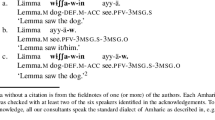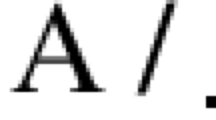Abstract
This article considers the problem of choosing the genitive or accusative case of an object with a transitive verb under negation in the diachronic aspect from the 18th century to the beginning of the 21st century. The purpose of the study is to determine in which period and to what extent the choice of the case was influenced by the object’s certainty factor. The material is the examples from the main body of the National Corpus of Russian language with the presumptive object, that is, the names of relatives in the female line.















Similar content being viewed by others
Notes
In the generation register according to the communicative grammar of G.A. Zolotova.
e-mail: ruscorpora.ru
Since the 1750s, the main corpus does not give earlier examples with the names of relatives.
REFERENCES
Tomson, A.I., Vinitel’nyi padezh pryamogo dopolneniya v otritsatel’nykh predlozheniyakh v russkom yazyke. Otd. ott. iz “Russkogo Filologicheskogo Vestnika” (Accusative Case of Direct Object in Negative Russian Sentences. Offprint from Russian Philological Bulletin), Warsaw: Tipografiya Varshavskogo Uchebnogo Okruga, 1902.
Itskovich, V.A., Sketches of the syntactic norm, in Sintaksis i norma (Syntax and Norm), Zolotova, G.A., Ed., Moscow: Nauka, 1974, pp. 43–106.
Mustajoki, A. and Heino, H., Case selection for the direct object in Russian negative clauses, in Part II: Report on a Statistical Analysis: Slavica Helsingiensia 9, Helsinki: Department of Slavonic Languages, University of Helsinki, 1991.
Paducheva, E.V., Genitive of the object in negative sentences, Vopr. Yazykozn., 2006, no. 6, pp. 21–43.
Russkaya grammatika (Russian Grammar), vol. 2: Sintaksis (Syntaxis), Moscow: Nauka, 1980.
Prakticheskaya russkaya grammatika, izdannaya Nikolaem “Grechem” (Practical Lessons of Russian grammar, Published by Nikolai Grech), St. Petersburg: Tipografiya Imperatorskago Sanktpeterburgskago Vospitatel’nago Doma, 1827.
Krylov, S.A., Determination of the name in the Russian language: Theoretical problems, Semiotika Inf., 1997, no. 35, pp. 244–271.
Bulygina, T.V. and Shmelev, A.D., Spatio-temporal localization as a supercategory of a sentence, Vopr. Yazykozn., 1989, no. 3, pp. 51–61.
Shmelev, A.D., Russkii yazyk i vneyazykovaya deistvitel’nost' (Russian Language and Extra-Language Reality), Moscow: Yazyki slavyanskoi kul’tury, 2002.
Rusakova, M.V., Accusative vs. genitive in constructions with negation: Dynamics of relationships in the historical segment reflected by texts in the Russian National Corpus, in Elementy antropotsentricheskoi grammatiki russkogo yazyka (Elements of the Anthropocentric Russian Grammar), Moscow: Yazyki slavyanskoi kul’tury, 2013.
Author information
Authors and Affiliations
Corresponding author
Ethics declarations
The authors declare that they have no conflict of interest.
Additional information
Translated by L. A. Solovyova
About this article
Cite this article
Fesenko, V.P. The Accusative Case as a Marker of Certainty of an Object with a Transitive Verb with Negation (Using Examples of Kinship Terms). Autom. Doc. Math. Linguist. 53, 189–202 (2019). https://doi.org/10.3103/S0005105519040034
Received:
Published:
Issue Date:
DOI: https://doi.org/10.3103/S0005105519040034




